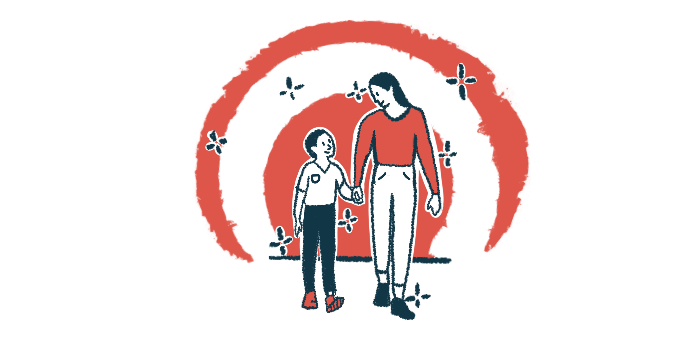Improvements in ‘mood/emotions’ reported for children on Altuviiio
Most parents of hemophilia A patients in trial 'very satisfied' with treatment

The parents of most children with severe hemophilia A who took part in the XTEND-Kids clinical trial of Altuviiio (efanesoctocog alfa) reported in exit interviews that the once-weekly treatment led to notable improvements in mood for their sons, with some reporting a greater ability for their boys to participate in social activities.
Indeed, in interviews with the caregivers of 20 children conducted after the study’s completion, 18 of 19 parents reported gains in “mood/emotions” among their boys after one year on Altuviiio. Six of eight parents also noted improvements in “social life/activity.”
“I let him do many more things… he rides a bike, he took [off] the little [training] wheels from his bike, I would have never accepted that before,” one caregiver said.
Another parent’s son “hasn’t had any joint bleeds and any trouble walking around since he started to use this new medication, and it’s long-lasting,” the caregiver reported.
The interview findings were presented at the 65th annual meeting of the American Society of Hematology (ASH), in an oral presentation titled “Experiences with Efanesoctocog Alfa: Exit Interviews with Caregivers of Previously Treated Patients with Hemophilia A from the XTEND-Kids Phase 3 Clinical Trial.” The work was funded by Sobi and Sanofi, Altuviiio’s co-developers.
Parents of 20 children took part in exit interviews after trial
Altuviiio is approved to treat hemophilia A in the U.S., Japan, and Taiwan, and is currently under review in Europe. A replacement therapy, it’s designed to deliver a functional version of factor VIII — the clotting protein that’s missing in people with hemophilia A — that has been modified to last longer in the body than the naturally-occurring version of the protein.
The Phase 3 XTEND-Kids trial (NCT04759131), completed early this year, assessed the safety and efficacy of once-weekly prophylactic (preventive) treatment with Altuviiio in more than 70 children with severe hemophilia A who had previously been on other therapies.
The results showed that most children were bleed-free after a year on prophylactic treatment with Altuviiio.
After the study was over, the researchers conducted semi-structured interviews with caregivers of some of the children who had participated in the trial. A total of 19 caregivers — 18 mothers and one father — were interviewed. One of the caregivers had two children with hemophilia who participated in XTEND-Kids, while the rest each had one child in the study.
The 19 parents interviewed reported that they were generally satisfied with Altuviiio, with all but one saying they were “very satisfied” with the treatment. Some of the key reasons for this satisfaction were that the treatment provided longer or better protection against bleeds, required fewer infusions per week, and left their child happier or more tolerant during treatment infusions.
[I am] very satisfied … because of the changes that I have noticed physically… and also emotionally… for both my son and our family.
All caregivers also said they preferred the once-weekly treatment over prior therapies their child had been given. One caregiver was said to be “very satisfied … because of the changes that I have noticed physically… and also emotionally… for both my son and our family.”
Nearly all of the parents said that, prior to entering the XTEND-Kids study, hemophilia A had a substantial impact on their child’s mood, as well as on their own emotional state. For most of the children, having hemophilia meant dealing with limitations or complications when participating in physical activities or going to school.
“It was stressful for me because he would be in pain and crying, and I hated seeing him that way,” one caregiver said. “I’d have times when I’d have to go and kind of step away and I’d break down and cry a little bit.”
Another caregiver said: “His biggest thing was he felt like he couldn’t participate in the same activities as his friends.”
New efficacy data show Altuviiio effective as on-demand treatment for bleeds
All but one of the caregivers said their child’s moods have improved since starting on Altuviiio. Most caregivers also reported that the therapy had made it easier for their child to participate in activities, socialize, and attend school.
“Actually I no longer pay attention. I let him live his life. I let him play with his friends,” said the caregiver whose son took off his bicycle’s training wheels.
These improvements have not just made life easier for the children, but also for their parents.
“I feel like obviously it’s given me a little more time. I kind of got used to just not [having time to myself], but it definitely gave me an option to kind of do a little more for myself,” one caregiver said.
Additional efficacy data from the trial also were presented at the ASH meeting, in a poster titled “Treatment of Bleeding Episodes with Efanesoctocog Alfa in Children with Severe Hemophilia A in the XTEND-Kids Phase 3 Study.”
These findings showed that while most children in XTEND-Kids were bleed-free during the trial, a total of 43 bleeds occurred during the study that required on-demand treatment with Altuviiio. Nearly half (49%) of these were joint bleeds.
For all but two of the bleeds that occurred, a single injection of Altuviiio was sufficient to control bleeding, “regardless of type or location.” In nearly all cases (97%), the efficacy of the treatment when used on an on-demand basis was rated as “excellent” or “good” by participants.
“Efanesoctocog alfa provided effective treatment and prevention of bleeding episodes in previously treated children [under] 12 years of age with severe hemophilia A,” the researchers wrote.






